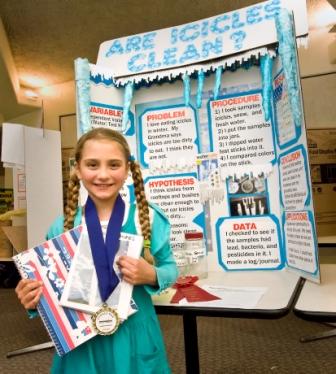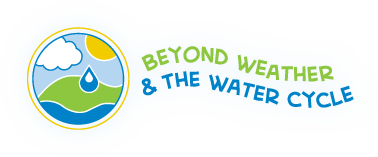In May 2011, the National Science Teachers Association (NSTA) reported that 75 percent of the surveyed members hosted a science fair during the past school year and 68 percent were planning a science fair for the 2011–2012 school year. Although many educators value science fairs as opportunities for students to “explore new ideas, apply and develop new skills, and demonstrate their learning” (NSTA 2011), an effective and interesting science fair can be challenging to pull off! However, with the help of your school librarian, science fairs can be “made over” into events that engage the entire school and showcase the positive outcomes of inquiry-based learning in the context of your state and local standards!

The winner in the first-grade division at the Brookhaven Labs Science Fair asked and answered the question "Are Icicles Clean?" Photo courtesy Brookhaven National Laboratory.
As we’ve discussed in prior columns, school librarians work toward achieving the American Association of School Librarians’ Standards for the 21st Century Learner. These standards encompass a number of learning activities relating to the school library, but in the case of science fairs, aspects of Standard 1 (inquire, think critically, and gain knowledge) particularly apply:
1.1.1 Follow an inquiry-based process in seeking knowledge in curricular subjects, and make the real-world connection for using this process in own life.
1.1.3 Develop and refine a range of questions to frame the search for new understanding.
1.2.1 Display initiative and engagement by posing questions and investigating the answers beyond the collection of superficial facts.
1.2.4 Maintain a critical stance by questioning the validity and accuracy of all information.
1.2.5 Demonstrate adaptability by changing the inquiry focus, questions, resources, or strategies when necessary to achieve success.
School librarians have long histories with science fair. At the elementary level, school librarians report that ideas for science fair projects are key components of their science collections (Mardis and Hoffman 2007) and that science fairs are a great opportunity for them to connect with their science teachers (Mardis 2011). Because school libraries are often the largest instructional spaces in the school, they are ideal places for displaying science fair projects.
Beyond space and idea books, school librarians have much to offer science fairs. A study of children’s questions to the Internet Public Library reference service showed that kids between third and eighth grade primarily asked questions about science fairs. Moreover, the questions were not just about science fair topics, they were about how to conduct experiments and how to display results (Mardis 2009). Another study showed that when children do not understand how to conduct their science fair experiments, their parents take over (Watson 2003)!
Students and teachers have found the science fair particularly frustrating because the topics range widely and it’s difficult to organize projects on so many different topics. Using your state or local standards as a guide, you can develop a theme for your science fair and work closely with your school librarian to ensure that this focus is reflected in the topics your students choose.
Let’s follow an example of how you might work with your school librarian on a science fair project relating to the theme of this issue of Beyond Weather and the Water Cycle: “Earth’s Climate Changes.” Because this theme encompasses many topics, let’s focus our example project on tree rings.
Step 1: Help children to understand why the science fair is important.
Although this step seems obvious, many science teachers do not spend adequate time helping their students understand why the science fair is an important part of their learning.
While videos like Treeline Elementary’s Fourth Grade Science Fair,
a digital poster such as “Mrs. Hunt’s Science Fair Hints,”

To see the entire glog click here.
or Christine Little’s “Why Participate in a Science Fair?” presentation,
can help kids to envision the outcome of their projects, it’s always helpful to help students understand what a tremendous opportunity science fair can be to make friends and learn about future careers.
The Science News for Kids article “The Science Fair Circuit” can show kids how they can enjoy science fair activities throughout their school years and even use the fair as a way to get to know people across the country and learn about college scholarships. Answers to the Internet Public Library’s question Why should I do a science fair project? can help you set expectations and build excitement.
Step 2: Identify an appropriate topic and a testable question for the science fair project.
As most science teachers know, the Internet teems with sites that list project ideas for science fairs. Perhaps you’ve already seen the Internet Public Library’s directory of science fair idea sites or Science Buddies’ lists of science fair topics that just focus on weather. Your school librarian can quickly assemble a list of appropriate topics once he or she is aware of your science fair’s theme.
Helping children choose questions for science fair projects is a place where your school librarian can shine! As we saw in the Standards listed above, the ability to phrase compelling questions is a key part of learning in the library. Working with your school librarian, you can help children focus their explorations of productive questions for their science fair projects.
The answers generated by productive questions are derived from first-hand experiences and raise children’s awareness of the possibility of more than one correct answer to a question. Productive questions cannot be answered by using a simple yes or no because they require children to test theories, before responding, through attention, focus, measuring or counting, comparison, action, problem solving, or reasoning—features of a great science fair project! With a good question, working on the rest of the science fair project is focused: background research is easier to conduct, results are easier to analyze, and conclusions come more naturally.
Vickie Harry of the Mediterranean Association for International Schools discusses types of testable questions in depth on her web site.She describes some varieties of questions that are especially well suited to younger students’ skills.
Measuring and Counting Questions
Quantitative questions encourage sharp observations and communications. Carefully phrased measuring and counting questions help children organize their thinking and unify similar concepts or ideas through the use of grouping or sets. Children use the science process skills of measuring and classifying as they check accuracy and use new instruments. Examples of measuring and counting questions include “How many…?”, “How often…?”, “How long…?”, and “How much…?”
Comparison Questions
Comparison questions ask children to identify number relationships, develop concepts of alike and different, quantify the number of ways things are alike or different, and describe how things fit together. The science processes of observing, measuring, classifying, and communicating are used by children as they answer comparison questions. Comparison question starters include: “How do…fit together?”, “How are…different?”, “In how many ways are…alike?”, and “In how many ways do…differ?”
Action Questions
Action questions involve children in the science process skills of predicting, investigating, and experimenting. Finding the answers to “What happens if…?” and “What would happen if you…?” engages children in the process of inquiry to discover an answer through investigation and experimentation. Asking children to make predictions about the outcomes of investigations or experiments stimulates thinking about variables, hypotheses, and conclusions affecting the investigation before it begins.
Often, choosing the right question is a matter of phrasing. The Discovery Channel’s Science Fair Central web site presents examples of questions rephrased from unproductive to testable, productive questions.
For this article, we’ve chosen tree rings as our example, but for your students, choosing their own topic is much more challenging and can mean the difference between a great science fair experience and a frustrating one! Work with your librarian to be prepared with a list of possible topics and questions.
Step 3: Review the scientific method and processes for conducting science experiments.
A good science fair project involves much more than a topic. Grasp of the process is important for making the science fair an experience that translates to other learning activities.
For example, teacher Mark Holmes gives an overview of all of the necessary things to consider before undertaking a science fair project in his TeacherTube video Successful Science Fair Projects.
A good project takes a lot of preparation and that’s when the student-teacher ratio in the classroom can become difficult. As an instructional collaborator, your school librarian can facilitate the planning process with you, using a number of methods like the Know-Want to Know-Learn (K-W-L) process worksheet.
Step 4: Ground the topic in appropriate research and references.
Grounding the testable questions in known research is an essential part of drawing conclusions from collected data. In the first column in this series, Questions, Questions: Taking Energy Inquiry Further in the School Library, we reviewed a number of research processes appropriate for elementary grades. For the science fair, you may want to focus on the location of information in books and web sites and allow children to focus on analysis and synthesis of information.
As an information specialist, your school librarian can recommend or gather a variety of high quality informational sources for children to review before beginning their experiments. In addition to the many print resources available through the school library, your school librarian can focus kids’ searching and reading by assembling links to digital magazine articles and videos. For our tree rings experiment, the school librarian might lead us to sources such as
Fossil Forests by Emily Sohn at Science News for Kids
Life of a Tree by the National Arbor Day Foundation
Tree Ring Analysis by Earth Day Canada
Real Trees 4 Kids by the National Christmas Tree Association
Talking Trees: A living diary of climate from the National Science Foundation’s Why Files
Note that each of these sources includes both text and pictures and most are of an appropriate elementary reading level. Imagine how long it would take you to help your students find appropriate resources like these for each of their projects using a web search engine!
Give children time to review their resources and write down one or two main ideas from each source. Schedule one-on-one meetings during your library time for you and your school librarian to review each child’s notes and make sure that they have a clearly defined question and good background sources.
Be sure that students record their sources in a bibliography. Your school librarian will have a range of resources for this activity, such as the formats presented at the Science Buddies site or web-based formatting tools like the free and easy-to-use NoodleBib Express.
Step 5: Conduct the experiment and gather data.
To continue with our example, tree-ring analysis can be conducted outdoors or with slices of trees that are brought in. The North Dakota Education Network has a lesson plan for tree-ring analysis that you can adapt for the data-gathering portion of this science fair project. Basically, the rings are counted backward from the bark. It may be helpful to mark every decade with a dot. Then, when rings are particularly wide, narrow, oddly shaped, or discolored, that means the tree experienced an unusual weather or physical event.
Step 6: Analyze data and draw conclusions.
Of course, data analysis will depend on the project. For this phase, you and your school librarian may want to check in with students as they collect and analyze their data, providing what library guru Joan Frye Williams calls “bookend service” (Mardis 2011). That is, check in on the children as they get started, occasionally as they work, and at the end of their activity to ensure that they are comfortable with the process.
For our example, one way to determine if a climate event may have influenced the tree’s development is to check the weather recorded for the year. The Weather Underground has a free weather history tool.
Although different research processes use different terms, drawing conclusions for a research question is really the result of a simple formula:
A (findings of prior research; known facts) + B (finding from experiment) = C (conclusion)
Be sure to emphasize that conclusions can affirm prior research, deny prior research, or present unexpected conclusions. Not all experiments result in “yes” or “no” answers!
Step 7: Display and communicate research findings in an understandable format.
Again, your school librarian can be a valuable partner here whether you decide you would like students to present their work on a traditional tabletop triptych or you’d like them to use a multimedia method like Glogster or Prezi. Digital formats can allow you to have multimedia products to show parents, administrators, and future students.
Glogster allows students to create interactive posters like the one below:

To see the interactive glog click here.
Prezi is similar to PowerPoint but with many more exciting features. We’ve already seen a Prezi about the reasons to participate in a science fair above, but a Prezi for our tree rings science fair project might look like this:
Conclusion
Your school librarian can be a valuable ally and collaborator in helping to get kids excited about and see the value in the science fair; develop good research questions and a sound, replicable process to pursue them; understand the link between their research results and research done by others; and present their project in a clear and dynamic way.
With your school librarian’s help, the science fair can be, as one Prezi noted, Not Your Mother’s Science Fair.
References
Mardis, M. A. 2009. Children’s Questions about Science Fair: Preliminary Results of an Analysis of Digital Library Reference Questions. Proceedings of the American Society for Information Science and Technology, 45 (1), 1-10.
Mardis, M.A. 2011. Reflections on School Library as Place, School Library as Space. School Libraries Worldwide 17 (1), pp.i-iii. Retrieved from http://findarticles.com/p/articles/mi_7728/is_201101/ai_n56829368/
Mardis, M. A., and Hoffman, E. S. 2007. Collection and Collaboration: Science in Michigan Middle School Media Centers. School Library Media Research, 10. Retrieved from http://www.ala.org/ala/mgrps/divs/aasl/aaslpubsandjournals/slmrb/slmrcontents/volume10/mardis_collectionandcollaboration.cfm
National Science Teachers Association. 2011. NSTA Members Don’t See Increasing Popularity for Science Fairs. Retrieved from http://www.nsta.org/publications/news/story.aspx?id=58461
Watson, J. S. 2003. Examining Perceptions of the Science Fair Project: Content or Process? School Library Media Research 6. Retrieved from http://www.ala.org/ala/aasl/aaslpubsandjournals/slmrb/slmrcontents/volume62003/sciencefair.cfm
Marcia Mardis, EdD, assistant professor, College of Information Science, Florida State University, wrote this article. Marcia is a former school librarian, school administrator, and educational digital library director. Email Marcia at beyondweather@msteacher.org.
Copyright July 2011 – The Ohio State University. This material is based upon work supported by the National Science Foundation under Grant No. 1034922. Any opinions, findings, and conclusions or recommendations expressed in this material are those of the author(s) and do not necessarily reflect the views of the National Science Foundation. This work is licensed under an Attribution-ShareAlike 3.0 Unported Creative Commons license.



